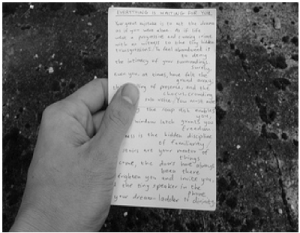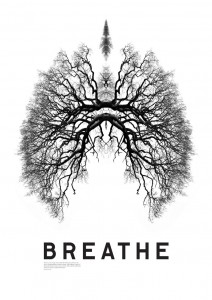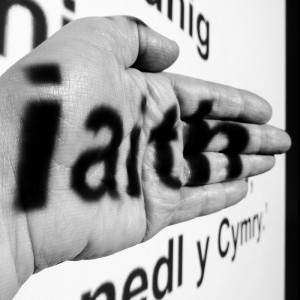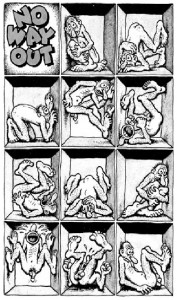 When learning a poem, there is sometimes a line, or maybe even a word which one is itching to rewrite. I am itching to get rid of that deity in the first stanza. Surely any of these edits would be preferable?
When learning a poem, there is sometimes a line, or maybe even a word which one is itching to rewrite. I am itching to get rid of that deity in the first stanza. Surely any of these edits would be preferable?
And even if we keep God, why should He, whatever He stands for here, be given in this intensely merely-being) poem of small lettered modesty, Commanding Capitalization?
If e.e. is the Jack Jones of the alphabet, ditching with hierarchical Upper Case for institutions, races, nationalities, tribes, landmarks, organisations, planets, holidays, why can’t God adhere to this egalitarian convention? Cummings wasn’t Jewish or Catholic where God reigns orthographically supreme, where in the former faith one is not even supposed to render His Name as a full consonant-vowel entity, but rather replace it with these coy referents: G_d, L_rd, F_ther. A practice which has always irritated me in the way that star-obscuring ones obcenities – b*stard, f*ck, sh*t – does too. Is not Unitarianism supposed to be a less fussy, kowtowing, more directly engaged relationship with the transcendental (“the focus of the service may be simply the celebration of life itself”) than other theological movements? As one would expect from a spiritual framework that attracts Emerson, Darwin, Newton, Dickens, Nightingale (Florence), Ray Kurzweil, and Mr WWW himself, Tim Berners-Lee to its ranks.
So I start learning the poem without God. But later on that day, with half an hour to kill, I find myself in entirely empty St Vedast Church, all the tourists preferring St Pauls just down the road, and I’m only here because Pod cafe next door is closed where I’d hoped to get a cup of tea. I’m always pleased to find myself in a church, marvelling at the peculiar dovetailed historical synchronicity of standing in a building that was constructed to keep the hubbub of medieval London shut out so that one might listen within, now functions equally well in a century where the clacking of carts and horses, the cries of street vendors, has been replaced by mobile phone beeps, squawks, and the unceasing rumble of cars and trucks.
Here, as I walk up the aisle, silence closing in around me like a protective cloak, the clatter and clutter of the world outside soothingly isolated, I take the poem out of my pocket once more and recite the first few lines, capitalised God and all.
For let’s say this be his house, abode, his dwelling place. The dwelling place of silence and reflection. Open to all, visited by hardly anyone. Maybe it’s OK to show some respectful placing-outside-of-conventions in keeping the uppercase just for Him, and no-one else. For all of this, and the few moment of quiet it gives me I say to e.e. or E.E, to God, G_d, or god, I am grateful.
—
To feel a sense of gratitude, our predisposition to ingratitude needs to be revisioned. Another way of thinking about this predisposition is through the notion of “habit”.
We don’t wake up each day with the express purpose of heedless fault-finding, dissatisfaction and grumbling ingratitude. But we do, on most days, look at the world through eyes configured at, or just below our baseline or set-point of happiness. This is also known as the hedonic treadmill. So fifty men and women, either leavened by good fortune, or sunk by bad (in this case lottery-winners and paraplegics), don’t stray in the long run that far from where they started from.
How, if at all, do we jog ourselves off the hedonic treadmill? Cummings does it, I think, through simple but startling linguistic inversions. Instead of “this most”, he gives “most this”; “blue true” rather than “true blue”, “human merely being” instead of “merely human being”. The effect is that of rinsing our tastingtouchinghearingseeingbreathing faculties to a point where the desired transcendent receptiveness of the concluding lines can be induced. Perhaps.
Reciting the whole poem, mantra-like, at the beginning of the day, which I have been trying to do on my morning walk this week, is intended to have a similar effect: an attempt to hijack the hedonic treadmill with schema-disconfirming data.
My hedonic treadmill is to be found in a dingy gym just off Holloway Road, with tinny KISS FM piping out of the TV sets hanging above our heads as we assiduously walk and run in place. No greenly spirit of trees or blue true dream of sky, certainly nothing natural, infinite yes about the activities there. Hard to be grateful on a treadmill, other than for the habitual certainties it provides.
But in reciting the poem, some kind of antidotal activation occurs. Dogs do something similar. How can their tongue-lolling, tail-wagging, thrilled response to a ball, a walk, a wheaten treat not enjoin us to take part in their world? And in so doing, dwell for as long as the time it takes us to recite the poem, or if we’re lucky, a bit longer, in something approximating contentment.
Read the full poem online.

 One of the best ways to cultivate gratitude is to establish a daily practice in which you remind yourself of the gifts, grace, benefits, and good things you enjoy. One of the best ways to do this is keeping a daily journal in which you record the blessings you are grateful for. Emmons’ extensive research has shown that this technique makes people happier. When we are grateful, we affirm that a source of goodness exists in our lives. By writing each day, we magnify and expand upon these sources of goodness. Setting aside time on a daily basis to recall moments of gratitude associated with even mundane or ordinary events, your personal attributes, or valued people in your life gives you the potential to interweave and thread together a sus- tainable life theme of gratefulness, just as it nourishes a fundamental life stance whose thrust is decidedly affirming.
One of the best ways to cultivate gratitude is to establish a daily practice in which you remind yourself of the gifts, grace, benefits, and good things you enjoy. One of the best ways to do this is keeping a daily journal in which you record the blessings you are grateful for. Emmons’ extensive research has shown that this technique makes people happier. When we are grateful, we affirm that a source of goodness exists in our lives. By writing each day, we magnify and expand upon these sources of goodness. Setting aside time on a daily basis to recall moments of gratitude associated with even mundane or ordinary events, your personal attributes, or valued people in your life gives you the potential to interweave and thread together a sus- tainable life theme of gratefulness, just as it nourishes a fundamental life stance whose thrust is decidedly affirming.![[Photo by Michelle Robinson: Black Dog Visitation series]](http://stevewasserman.co.uk/wp-content/uploads/2015/11/19942697499_e750dbfbb3_z-1-300x225.jpg)
![[Photo by Guido Caprini]](http://stevewasserman.co.uk/wp-content/uploads/2015/11/14393075726_2bfef29951_z-300x170.jpg)
 Surveys have revealed that people spend more time praying than doing just about anything else. 72 percent of people asked say that they pray at least once a day; 75 percent of people say they would like to spend more time in prayer, and over half (51 percent) say they pray before a meal. Most of the prayers are casually conversational rather than liturgically formal.
Surveys have revealed that people spend more time praying than doing just about anything else. 72 percent of people asked say that they pray at least once a day; 75 percent of people say they would like to spend more time in prayer, and over half (51 percent) say they pray before a meal. Most of the prayers are casually conversational rather than liturgically formal. Good health; being alive; no more skin allergies; I’m not fat; white teeth; exercise; eyes; ears; touch; physical strength; afternoon nap; ability to breathe; modern medicine, energy to get through the day; no broken bones. Each of these bodily-related blessings appeared in journals that Emmons’ research participants have kept. The physicality of gratitude is noticeable as gratefulness for the functioning of one’s body, recovery from illness, or for just being alive are some of the most commonly mentioned themes. Nearly 80 percent of his research participants say they are grateful for their health, or the health of family members, making it the most cited trigger of gratitude. Another frequently mentioned source of gratitude is the senses – the ability to touch, see, smell, taste, and hear.
Good health; being alive; no more skin allergies; I’m not fat; white teeth; exercise; eyes; ears; touch; physical strength; afternoon nap; ability to breathe; modern medicine, energy to get through the day; no broken bones. Each of these bodily-related blessings appeared in journals that Emmons’ research participants have kept. The physicality of gratitude is noticeable as gratefulness for the functioning of one’s body, recovery from illness, or for just being alive are some of the most commonly mentioned themes. Nearly 80 percent of his research participants say they are grateful for their health, or the health of family members, making it the most cited trigger of gratitude. Another frequently mentioned source of gratitude is the senses – the ability to touch, see, smell, taste, and hear. Enter Emmons’ family home and one of the first things you will see is a ceramic plaque above the hallway mirror with the words GIVE THANKS carved in the center. Help yourself to a drink from the refrigerator and you might see a magnet on the door quoting Eleanor Roosevelt: “Yesterday is history, tomorrow is mystery … today is a gift.” Now go over to the family room and look at the bookcase to the right of the windows. On one shelf is a pewter paperweight given to him by a close friend containing a passage from the author Melody Beattie: “Gratitude can turn a meal into a feast, a house into a home, a stranger into a friend:’
Enter Emmons’ family home and one of the first things you will see is a ceramic plaque above the hallway mirror with the words GIVE THANKS carved in the center. Help yourself to a drink from the refrigerator and you might see a magnet on the door quoting Eleanor Roosevelt: “Yesterday is history, tomorrow is mystery … today is a gift.” Now go over to the family room and look at the bookcase to the right of the windows. On one shelf is a pewter paperweight given to him by a close friend containing a passage from the author Melody Beattie: “Gratitude can turn a meal into a feast, a house into a home, a stranger into a friend:’ There is some research which shows that swearing a vow to perform a behaviour actually does increase the likelihood that the action will be executed. In one such study, members of a local YMCA who decided to participate in the Twelve-Week Personal Fitness Program agreed to “exercise three days per week for twelve weeks and beyond at the Y.” Once making the decision to participate, the experimental group was sworn to perform the promised behaviour. A second group signed a written commitment to perform the promised behaviour, and a third, control group, did not make any form of commitment.
There is some research which shows that swearing a vow to perform a behaviour actually does increase the likelihood that the action will be executed. In one such study, members of a local YMCA who decided to participate in the Twelve-Week Personal Fitness Program agreed to “exercise three days per week for twelve weeks and beyond at the Y.” Once making the decision to participate, the experimental group was sworn to perform the promised behaviour. A second group signed a written commitment to perform the promised behaviour, and a third, control group, did not make any form of commitment. In the late 1930s, the amateur linguist Benjamin Lee Whorf posed the theory that language determines the nature and content of thought. This “Whorfian” hypothesis inspired decades of research in a variety of disciplines, including linguistics, psychology, philosophy, anthropology, and education. To this day, it has not been completely disputed or defended but has continued to intrigue researchers around the world. Many have adopted a weaker form of the hypothesis, namely that language influences how we think rather than determining, in a rigid fashion, the very content of the thoughts.
In the late 1930s, the amateur linguist Benjamin Lee Whorf posed the theory that language determines the nature and content of thought. This “Whorfian” hypothesis inspired decades of research in a variety of disciplines, including linguistics, psychology, philosophy, anthropology, and education. To this day, it has not been completely disputed or defended but has continued to intrigue researchers around the world. Many have adopted a weaker form of the hypothesis, namely that language influences how we think rather than determining, in a rigid fashion, the very content of the thoughts. An ingenious series of experiments conducted a number of years ago showed that when people mimicked the facial expressions associated with happiness, they felt happier – even when they did not know they were moving the “happy muscles” in their face. Researchers have found that smiling itself produces feelings of happiness. How were they kept in the dark? Simple. They were asked to hold a pencil with their teeth. Doing so tends to activate the muscle we use when we smile (the zygomatic major). This muscle lifts the corner of the mouth obliquely upwards and laterally and produces a characteristic smiling expression. Try it now. You will smile. Now, take that pencil and hold it in your lips, pointing it straight out. A different set of muscles are now activated, those that are involved in frowning (these are the ones targeted by Botox treatments). Why this clever ruse? You can’t let subjects in the study know that they are supposed to be feel-ing happy, because that would have unintended consequences on the behavioral rating of interest.
An ingenious series of experiments conducted a number of years ago showed that when people mimicked the facial expressions associated with happiness, they felt happier – even when they did not know they were moving the “happy muscles” in their face. Researchers have found that smiling itself produces feelings of happiness. How were they kept in the dark? Simple. They were asked to hold a pencil with their teeth. Doing so tends to activate the muscle we use when we smile (the zygomatic major). This muscle lifts the corner of the mouth obliquely upwards and laterally and produces a characteristic smiling expression. Try it now. You will smile. Now, take that pencil and hold it in your lips, pointing it straight out. A different set of muscles are now activated, those that are involved in frowning (these are the ones targeted by Botox treatments). Why this clever ruse? You can’t let subjects in the study know that they are supposed to be feel-ing happy, because that would have unintended consequences on the behavioral rating of interest. If we want to make the most out of opportunities to flex our gratitude muscles, then we must creatively look for new situations and circumstances in which to feel grateful. Just when I thought I had fully grasped the conceptual basis of gratitude, an article came across my desk describing two “anomalous cases” of gratitude not fitting the usual dynamic of the giving and receiving of goodness between benefactor and beneficiary.
If we want to make the most out of opportunities to flex our gratitude muscles, then we must creatively look for new situations and circumstances in which to feel grateful. Just when I thought I had fully grasped the conceptual basis of gratitude, an article came across my desk describing two “anomalous cases” of gratitude not fitting the usual dynamic of the giving and receiving of goodness between benefactor and beneficiary.